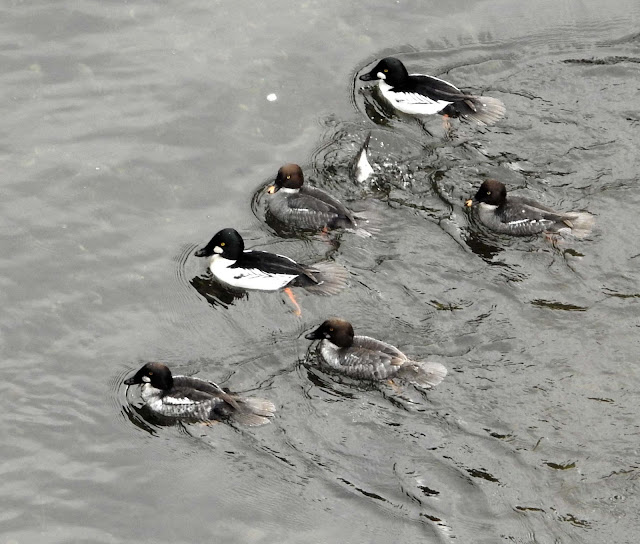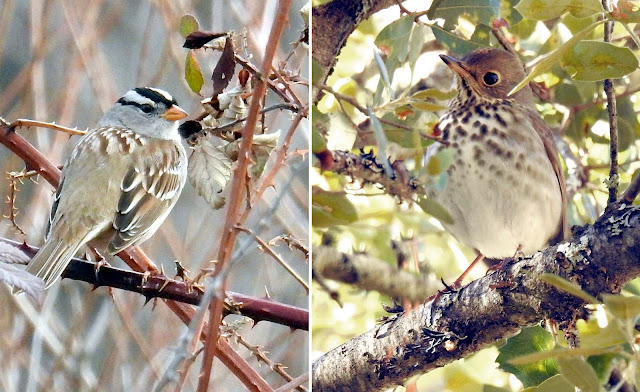Rock Creek high water
Three separate "atmospheric rivers", in the past two weeks, brought 19.52" of rain to our area! This brings us to a water-year total of 51.02"!!! The river was running high and fast, at 9,000 cfs (cubic feet per second), with a gauge height of 12'!!! We didn't get any snow at all, as the snow level was up around 6,000' to 7,000' in elevation.
The creek behind our house was a blurred torrent of crashing water for days, and so was the river! At first they were so full of sediment that I named them the "Mocha Expresses". Now they have slowed down and their clarity has been restored. Needless to say I didn't get outside with my camera very much!
Sharp-shinned Hawk (juvenile)- Accipiter striatus
We had periodic breaks when the sun came out, and I was able to wander about for a while. One morning, during a brief break in the rain, I spotted a bedraggled Sharp-shinned Hawk trying to dry out its feathers in the thin sunlight. Unfortunately it started raining soon after I spotted it, and it took off. The following day was sunny and cool, but at least no rain. Hopefully it was able to dry off!
This is the first Sharp-shinned Hawk I've seen this year! One used to perch on the dead top of an alder tree near our garden, and I would often see it there. Unfortunately the top of the alder broke off last winter and the Sharp-shinned Hawk has been absent. They are the smallest hawk in the US and Canada, measuring 11' in length with a wingspan of 23". They are forest predators, like the Northern Goshawk.
The Cornell Lab of Ornithology states, "These raptors have distinctive proportions: long legs, short wings, and very long tails, which they use for navigating their deep-woods homes at top speed in pursuit of songbirds and mice."
They use surprise attack as their main method of capture. They will eat birds as small as an Anna's Hummingbird, or as large as a Mountain Quail! They will pluck off most of the feathers of their prey before they eat them! They are common visitors to our area in winter and occasionally breed here. I hope to see it again in the near future!
North Yuba River in HIGH water
The North Yuba River was also way wider with the increased amount of rainfall!
Common Goldeneyes (4 females, 2 males) - Bucephala clangula
When the river was ripping along I didn't see any ducks. However, when it calmed down they reappeared. The only ducks on the river right now are these lovely Common Goldeneye Ducks, already in their mating colors.

Common Goldeneyes (1 female, 4 males) - Bucephala clangula
One afternoon, the angled winter light illuminated the iridescent green feathers on the heads of the male ducks. Such beauty!
In the Forest
This winter, my husband and I have been driving a few miles from our home to a sunnier spot to hike. It is surprising how the forest differs from our neighborhood! It has lots of Madrones, Live Oaks, Ponderosa Pines, and Douglas Firs. There is a beautiful view of the river there, where we often picnic in the sun! This week we came across some active Ladybird Beetles, that were busy mating. You can see the mating ones in the photo above. Just look for two or three beetles on top of each other!
Here's a video with several pairs of mating Ladybird Beetles!
Winter Russula - Russula cremoricolor
In one area we found about ten of these Winter Russula mushrooms! Their bright pinkish-red caps make them easy to spot. I'm surprised how quickly they have sprouted since the rain!
Wikipedia states; "Russula cremoricolor, also known as the winter russula, is a species of gilled mushroom.This mushroom has red, cream-yellow, and pink color variants, which complicates attempts at field identification, although finding "red and creamy capped fruitbodies in close proximity is a good clue indicating this species". The winter russula is "mildly toxic,"and causes intestinal distress even when consumed in small amounts. The red morph was previously identified as Russula silvicolor,but was found to be genetically identical to the cream-colored individuals called R. cremoricolor. The red morph is superficially similar to Russula californiensis but R. cremicolor has a much sharper, peppier taste, likes to associate with mixed forest or tanoak rather than pine, and keeps its gills and stipe white even in age."
Bushtit - Psaltriparus minimus
There were lots of little birds flitting around in the bushes. They were hard to identify or photograph because they kept moving around, resting a second or less in one spot. Later on we got a clear view of a Ruby-crowned Kinglet as well as a male (females have a white eye-ring) Bushtit! Both of these tiny (4.5" in length) birds glean spiders, insects, and their eggs, from the branches and leaves of plants.
Bushtits live year-round in California. Most of the year they live in flocks of 10-40 birds. In the end of February to early March, they pair off to breed and build their nest. It will take both the male and the female a month or more to build their amazing, 6"-12", sock-like nest of spider webs and plant material! I've seen these nests in museums, but never in the wild. It would be fabulous to find one! They female lays 4-10 eggs in the nest, and may have two broods in a season. Interestingly, adult male offspring help the mated pair raise their young! Also, incredibly the whole family sleep together in the sock-like nest!
Ruby-crowned Kinglet - Corthylio calendula
Ruby-crowned Kinglets are named for the bright scarlett "crown patch" the male exhibits when excited or antagonized. Most of the time the crown isn't visible. These tiny birds mainly inhabit the snow-free foothills during winter, but move up to the Lodgepole/Hemlock forests to breed, around 9000' in elevation. I've seen these little birds all winter in my neighborhood this year. Their fluffy, thick plumage keeps them warm at night.
This week the forecast is for showers, clouds, and even some sunny days! Yay! It will be a nice break from the pouring rain!
Where are the mammals?
What plants are blooming?
What insects are out and about?
Check back in two weeks for the answers to these questions and more!
After 8 years of posting my blog, I've decided that I'm only going to post my blog every TWO weeks from now on. Check back in two weeks, on March, 1st for my next natural history blog.
Also, check out my latest post on my newly re-opened Damp Earth Blog at dampearthart.blogspot.com



























